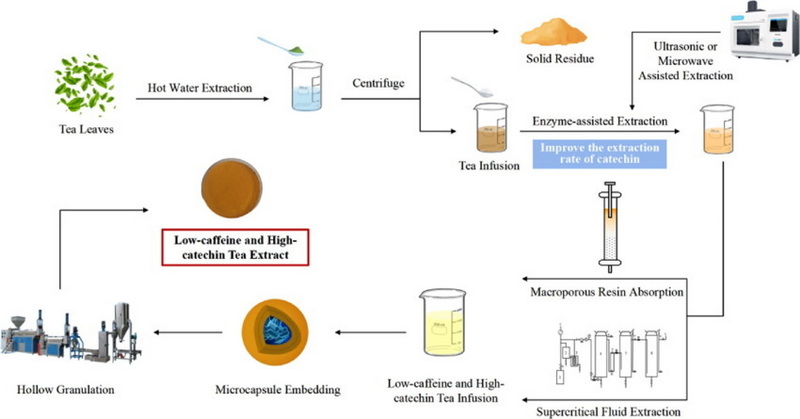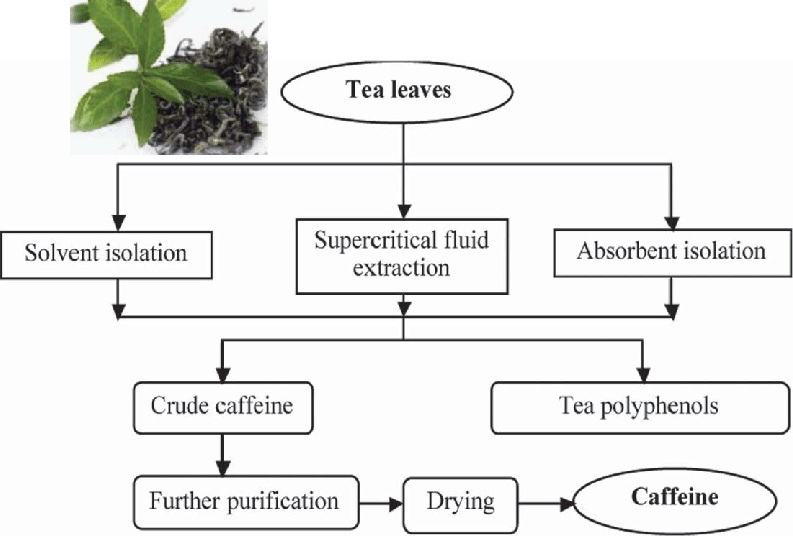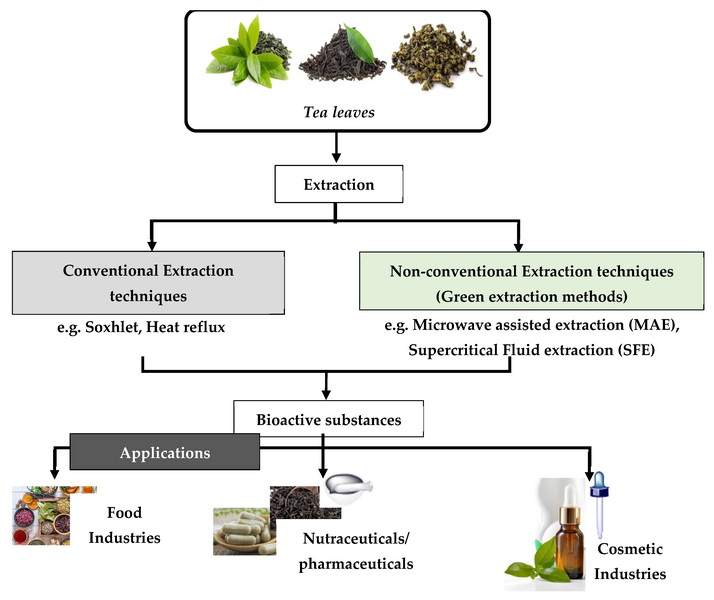Content Menu
● Understanding Caffeine in Green Tea
● The Chemistry of Caffeine
● Methods of Caffeine Extraction
>> 1. Solvent Extraction
>> 2. Microwave-Assisted Extraction (MAE)
>> 3. Ultrasound-Assisted Extraction (UAE)
● Detailed Extraction Process
>> Materials Needed
>> Step-by-Step Instructions
● Benefits of Caffeine Extraction
● Applications of Extracted Caffeine
>> 1. Food and Beverage Industry
>> 2. Pharmaceuticals
>> 3. Cosmetics
>> 4. Nutraceuticals
● Safety Considerations
● Conclusion
● FAQ
>> 1. What is the best method for extracting caffeine from green tea?
>> 2. Is it safe to use solvents for extraction?
>> 3. Can I extract caffeine without special equipment?
>> 4. How pure is the extracted caffeine?
>> 5. What are some uses of extracted caffeine?
● Citations:
Caffeine extraction from green tea is a fascinating process that can be achieved through various methods. This article will guide you through the steps, techniques, and considerations involved in extracting caffeine from green tea. We will also explore the benefits and uses of caffeine, as well as address common questions related to the extraction process.

Understanding Caffeine in Green Tea
Caffeine is a natural stimulant found in various plants, including tea leaves. Green tea, known for its health benefits, contains caffeine along with other compounds such as catechins. The extraction of caffeine can be beneficial for those looking to isolate this compound for various applications, including dietary supplements and research.
The Chemistry of Caffeine
Before diving into extraction methods, it's essential to understand the chemistry behind caffeine. Caffeine (1,3,7-trimethylxanthine) is an alkaloid that acts as a central nervous system stimulant. It can enhance alertness and reduce fatigue. In green tea, caffeine works synergistically with other compounds like L-theanine, which promotes relaxation without drowsiness. This unique combination contributes to the characteristic calming yet alert effect of green tea.
Methods of Caffeine Extraction
There are several methods to extract caffeine from green tea, each with its advantages and disadvantages. Below are some common techniques:
1. Solvent Extraction
This method involves using a solvent to dissolve the caffeine from the tea leaves. Common solvents include dichloromethane, ethanol, and methanol.
Procedure:
- Boil green tea leaves in water.
- Add sodium carbonate to convert tannins into salts that remain in the aqueous layer.
- Use an organic solvent to extract caffeine from the mixture.
Advantages:
- Effective for isolating caffeine.
- Can yield high purity levels.
Disadvantages:
- Requires careful handling of solvents.
- May involve complex purification steps.
2. Microwave-Assisted Extraction (MAE)
Microwave-assisted extraction utilizes microwave energy to enhance the extraction process. This method is known for its efficiency and speed.
Procedure:
- Mix green tea leaves with water and a small amount of acid.
- Place the mixture in a microwave for a predetermined time.
- Filter the solution to obtain caffeine.
Advantages:
- Faster than traditional methods.
- Higher extraction efficiency.
Disadvantages:
- Requires specialized equipment.
- May not be suitable for all types of tea.
3. Ultrasound-Assisted Extraction (UAE)
Ultrasound-assisted extraction employs ultrasonic waves to facilitate the extraction process by creating cavitation bubbles in the solvent.
Procedure:
- Combine green tea leaves with a solvent in an ultrasonic bath.
- Apply ultrasound for a specific duration.
- Filter the solution to isolate caffeine.
Advantages:
- Reduces extraction time.
- Can improve yield compared to traditional methods.
Disadvantages:
- Equipment costs can be high.
- Requires optimization of parameters like temperature and time.

Detailed Extraction Process
Here's a step-by-step guide on how to extract caffeine from green tea using solvent extraction:
Materials Needed
- Green tea leaves (10 grams)
- Sodium carbonate (6 grams)
- Dichloromethane or another organic solvent (45 mL)
- Distilled water (90 mL)
- Beaker
- Heating source
- Vacuum filtration setup
Step-by-Step Instructions
1. Preparation of Tea Solution:
- Place 10 grams of green tea leaves into a beaker.
- Add 90 mL of distilled water and bring it to a boil.
2. Adding Sodium Carbonate:
- Once boiling, add 6 grams of sodium carbonate to the solution. This will help precipitate tannins.
3. Boiling:
- Continue boiling for about 10 minutes while stirring occasionally. This allows caffeine and tannins to dissolve into the water.
4. Separation:
- After boiling, let the solution cool slightly before filtering it through vacuum filtration to remove solid particles.
5. Extraction with Solvent:
- In a separate container, mix the filtered solution with 45 mL of dichloromethane.
- Stir gently and allow the mixture to settle into two layers (aqueous and organic).
6. Collecting Caffeine:
- Carefully separate the organic layer containing caffeine from the aqueous layer using a pipette or separating funnel.
- Evaporate the solvent under reduced pressure or in a fume hood to obtain crude caffeine crystals.
7. Purification (Optional):
- If higher purity is required, recrystallize the crude caffeine using ethanol or another suitable solvent.
Benefits of Caffeine Extraction
Extracted caffeine can be used for various purposes:
- Dietary Supplements: Caffeine is often included in energy supplements due to its stimulant properties.
- Research: Isolated caffeine can be used in scientific studies examining its effects on health and metabolism.
- Cosmetics: Some cosmetic products incorporate caffeine for its potential skin benefits, such as reducing puffiness and improving circulation.
Applications of Extracted Caffeine
The extracted caffeine has numerous applications across different industries:
1. Food and Beverage Industry
Caffeine is widely used in energy drinks, sodas, and coffee products. Manufacturers often seek high-purity caffeine extracts to enhance flavor profiles or boost energy content without altering other ingredients significantly.
2. Pharmaceuticals
In pharmaceuticals, caffeine is utilized for its analgesic properties when combined with pain relievers like aspirin or acetaminophen. It enhances their effectiveness by increasing absorption rates and providing additional pain relief.
3. Cosmetics
Caffeine is increasingly found in skincare products due to its antioxidant properties and ability to constrict blood vessels temporarily, which helps reduce redness and puffiness around the eyes. Its inclusion in anti-cellulite creams is also popular due to its purported ability to stimulate circulation and break down fat cells.
4. Nutraceuticals
Caffeine is often included in weight loss supplements due to its metabolism-enhancing effects. It can increase fat oxidation during exercise and improve endurance performance by reducing perceived exertion levels.
Safety Considerations
While extracting caffeine can be beneficial, it's crucial to consider safety precautions:
1. Handling Solvents: Organic solvents can be hazardous if inhaled or absorbed through skin contact. Always work in a well-ventilated area or under a fume hood when using solvents like dichloromethane or ethanol.
2. Disposal: Properly dispose of any waste materials according to local regulations regarding hazardous waste disposal.
3. Dosage Awareness: If using extracted caffeine for consumption or supplementation, be aware of recommended dosages as excessive intake can lead to adverse effects such as insomnia, increased heart rate, or anxiety.
Conclusion
Extracting caffeine from green tea can be accomplished through several methods, each with unique advantages and challenges. Understanding these methods allows enthusiasts and researchers alike to effectively isolate this compound for various applications. The choice of method will depend on factors such as desired purity, available equipment, and specific goals of extraction.
By exploring both traditional techniques and modern advancements like microwave-assisted or ultrasound-assisted extraction, one can optimize their approach based on available resources and desired outcomes. The versatility of extracted caffeine makes it valuable across multiple industries—from food production to pharmaceuticals—highlighting its significance beyond just being a simple stimulant found in beverages.

FAQ
1. What is the best method for extracting caffeine from green tea?
The best method depends on your goals; microwave-assisted extraction offers speed and efficiency, while solvent extraction provides high purity levels.
2. Is it safe to use solvents for extraction?
Yes, but safety precautions must be taken when handling organic solvents due to their toxic nature.
3. Can I extract caffeine without special equipment?
Yes, simple methods like boiling with sodium carbonate can yield results without specialized equipment; however, efficiency may vary.
4. How pure is the extracted caffeine?
Purity can vary based on the method used; recrystallization can enhance purity after initial extraction.
5. What are some uses of extracted caffeine?
Extracted caffeine is used in dietary supplements, research studies, and cosmetic products due to its stimulant properties and potential health benefits.
Citations:
[1] https://www.youtube.com/watch?v=RIbff5iD0GQ
[2] https://www.researchgate.net/profile/Jeyanthi-Rebecca/publication/276272121_EXTRACTION_OF_CAFFEINE_FROM_USED_TEA_LEAVES/links/558cdede08aee43bf6ae471a/EXTRACTION-OF-CAFFEINE-FROM-USED-TEA-LEAVES.pdf
[3] https://pmc.ncbi.nlm.nih.gov/articles/PMC6049776/
[4] https://pmc.ncbi.nlm.nih.gov/articles/PMC4444893/
[5] https://pubmed.ncbi.nlm.nih.gov/20546396/
[6] https://asianpubs.org/index.php/ajchem/article/download/11515/11497/11541
[7] https://www.researchgate.net/publication/261550337_Caffeine_in_Green_Tea_Its_Removal_and_Isolation
[8] https://www.arcjournals.org/pdfs/ijarcs/v6-i9/2.pdf

 English
English





























